Week Ten: Florence to Venice
- Hannah Stevenson
- Mar 28, 2024
- 14 min read
We only had two days left in Florence and discovered that most places we planned to go were closed on Mondays (bummer). It turned out to be a blessing in disguise as we discovered the Basilica of Santa Croce was open and not crowded at all.

We're getting to the point in this trip where we see churches like this and say, "Oh, what a nice little church." 😆 Little did we know that it held some very important treasures inside.

The walls were filled with paintings, each telling a story from Christ's and the Apostle's lives. Norah liked the idea that the walls were like a big graphic novel, telling stories through pictures. For Mediaeval people, often illiterate, this was one of the ways they could learn the stories of the Bible and Saints.

One of the treasures was Michelangelo's resting place! Even though Michelangelo was Florentine and loved his town, he spent the last three decades of his life in Rome. This self-imposed exile started when Alessandro de’ Medici was made the first duke of Florence. Michelangelo considered him a tyrant, so from the 1530s, even after Alessandro’s death, he preferred living under the rule of the popes in Rome.
When Michelangelo died on February 18, 1564, he was initially laid to rest in the SS. Apostoli church in Rome. However, when Duke Cosimo I de Medici heard about this development, he declared that since he could not employ Michelangelo and honor him in Florence during his life, he would honor him in death with a state funeral and a proper tomb in Florence. Lionardo Buonarroti, Michelangelo’s nephew and heir, was assigned the task of ‘stealing’ the corpse. He had it sent secretly in a bale of hay, disguising it as a piece of merchandise. This way, no one in Rome, including the Pope, would be able to prevent the movement of Michelangelo’s body back to Florence.

The artistic domains of Painting, Sculpture, and Architecture are depicted as three muses mourning the loss of the great artist. Each holds the tools of the artistic trade she represents, and which are still used by painters and sculptors today. You can learn more about Michelangelo's tomb here.

Next, we saw Galeleo's tomb! The idea of a monument to Galileo instantly aroused strong opposition in clerical circles. They felt it inappropriate to celebrate the memory of a man suspected of heresy. Almost a century passed before a monument celebrating the great scientist was erected in the basilica's north aisle opposite the tomb of Michelangelo. The situation was only resolved thanks to the intervention of Grand Duke Gian Gastone de' Medici (1671–1737) and his policy based on modernizing the state to curb the power of the Church.
The sarcophagus, with two statues on either side, sits on a tall, three-part plinth. On the left Astronomy holds a parchment with sunspots, while on the right Geometry displays a plank on an incline demonstrating the equation of falling bodies. Above the tomb, a niche modeled to resemble a shell contains a bust of Galileo.
Galileo is shown gazing at the heavens while clutching a telescope in his right hand, while his left-hand rests on a celestial globe set on a pile of books and a compass. In the centre of the scroll we see Jupiter with its moons, which Galileo discovered and christened the "Medici planets". Source

I had never heard of poet and playwright Vittorio Alfieri, but we loved this one. He died in 1803, and sculptor Antonio Canova was commissioned to produce a monumental tomb. After devouring the poet's works and laboring long and hard, Canova created a monumental tomb he described as "as solemn and majestic as I could make it, so that the nature of my work should match the loftiness of the great poet's pen".The monument centers around the majestic figure of Italy weeping before a tomb adorned with a medallion showing the bust of Alfieri in profile. A horn of plenty lies before the tomb, while the masks at the sides allude to the art of tragedy and the laurel wreath and lyre to poetry. The monument combines the formal perfection of its classicizing costumes and decoration with a celebration of the poet through the depiction of a suffering country paying tribute to the tomb of its illustrious son. Source

We were delighted to see Florence Nightingale too! I have sweet memories of teaching the kids about her in our homeschool years ago and of little nine-year-old Laurel bringing me food while holding a camping lantern when I was sick with the flu a few weeks later. Florence isn't buried here, but the statue pays tribute to her. We learned she was born in Florence and named after this beautiful city!

Just some detail on one of the monuments. It's pretty marvelous to think of all the skill and time even the smallest details must have taken.

There were many little chapels throughout. This fresco in one of them stopped me in my tracks. It is called the Last Supper and the Tree of Life. You can read more about it here.

It poured rain the whole time we were in Florence.

But the food was SO good!

The beautiful Arno River in the rain.

Details outside our AirBnb...




Tuesday was our last day in Florence, so we wanted to make it count! We headed to see Michelangelo's David by way of the Duomo (more on that later).

And found the line outside the Galleria dell'Accademia where he is on display. We were in Florence right before the peak season started, so we hoped we would be fine but the line turned out to be pretty long.

So we decided to have an early lunch while we waited. Good choice! We were full and happy once we finally got in two hours later.

The first thing we saw when walking in was the Abduction of a Sabine Woman by the Flemish sculptor and architect Giambologna. This work is widely considered his masterpiece.

On our way to see David, we saw four other statues made by Michelangelo. They are some of the finest examples of Michelangelo’s habitual working practice, referred to as “non-finito” (or incomplete), magnificent illustrations of the difficulty of the artist in carving out the figure from the block of marble and emblematic of the "struggle of man to free the spirit from matter". You can read more about them here.

Here he is in all of his glory! As we stood in line, we read more about David; here's what we learned.

So lifelike - the details were astounding.





We saw so many other beautiful paintings


They were huge and so incredible. And then...

We entered this unusual gallery filled with hundreds of plaster-cast sculpture models.
The Gipsoteca Bartolini (Hall of Models) is a unique space where the museum’s origins as a teaching gallery are on display. The Accademia Gallery was first created for students of the art academy next door to study the works of great artists. One of these greats was the 19th-century sculptor and academy professor Lorenzo Bartolini. The Gipsoteca, a loose recreation of his studio, holds a collection of more than 250 plaster models of Bartolini’s sculptures, as well as those of his protégé, Pampaloni.


The plasters are made of clay and then treated with patina. Many appear speckled with dark spots where nails were used as reference points for transferring the cast to the marble block. Sometimes, the plaster cast is accompanied by a photo of the finished piece, giving a fascinating glimpse into the careful craft of building models for the era’s elegant marble sculptures. I found a great timelapse video showing the process if you're interested.


Next, we headed to the amazing Florence Cathedral (in Italian: Duomo di Firenze); the building of this masterpiece began in 1296 in the Gothic style to a design of Arnolfo di Cambio and was structurally completed by 1436, with the dome engineered by Filippo Brunelleschi. The exterior is faced with marble in various shades of green and pink, bordered by white, and has an elaborate 19th-century Gothic Revival façade by Emilio De Fabris.
The basilica is one of Italy's largest churches, and until the development of new structural materials in the modern era, the dome was the largest in the world. It remains the largest brick dome ever constructed.

Again, pictures do it no justice!
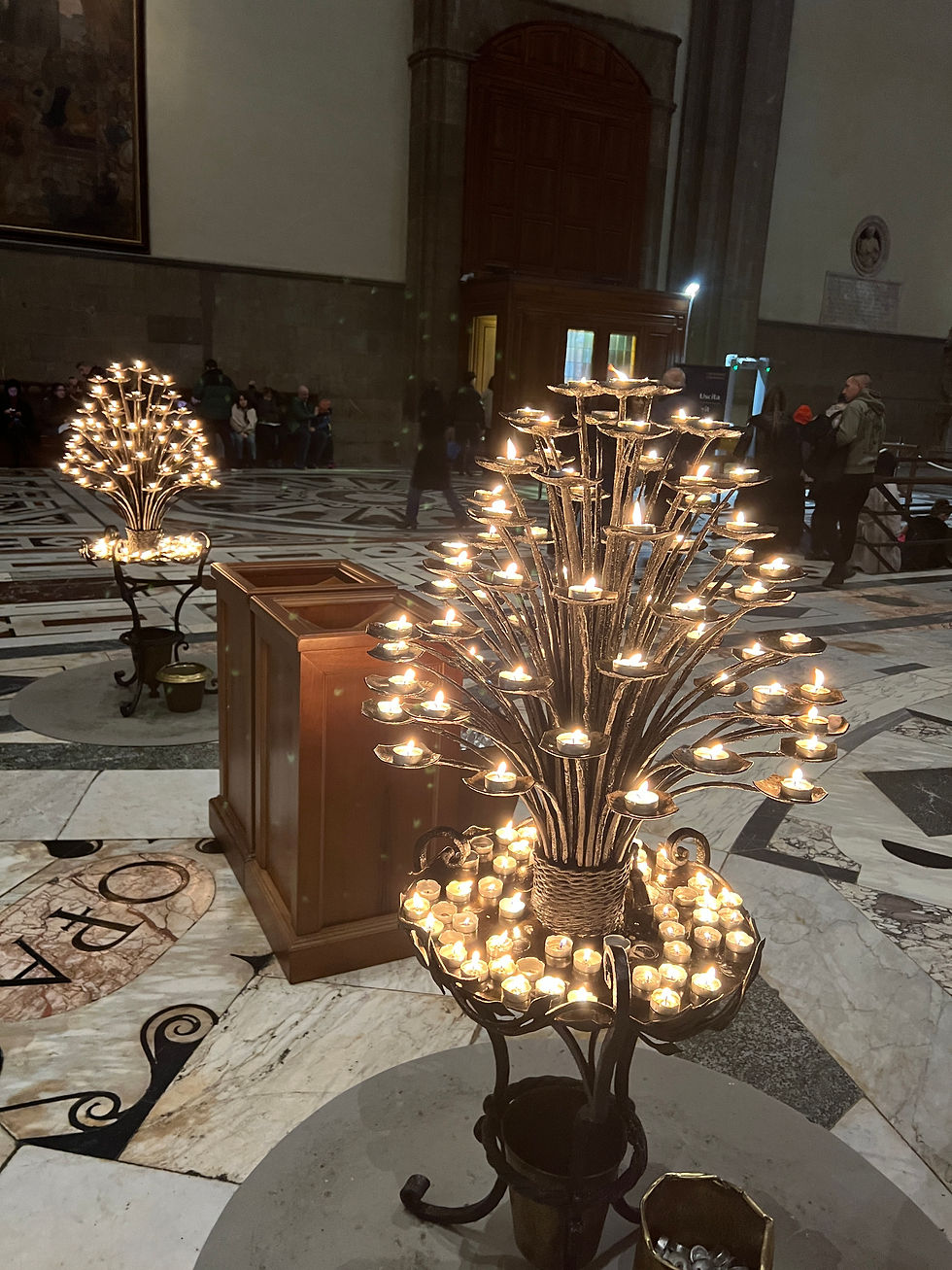
Inside, we were invited to light a candle and look at the incredible dome.

The dome's ceiling is decorated with a representation of The Last Judgment. Originally, it was left whitewashed until the Grand Duke Cosimo I de' Medici decided to have the dome's ceiling painted. This enormous work, 338 x 750 ft of painted surface, was started in 1572 by Giorgio Vasari and would be completed in 1579. You can learn more about the Duomo here.

We heard that the best view of both the dome and the city could be had at the top of the bell tower (right behind us).

So we climbed the 414 steps to the top! 😅

And it was worth it. What a view!




Finally, riding home on the bus (after being lost for a bit). It was a long, wet day, but one we will not soon forget. Thanks, Florence!
We woke up early to get to the train station, on our way to Venice by way of...

Pisa! We are so glad we made the stop. It meant lugging around our suitcases, but it was well worth it!


We all took turns holding it up...



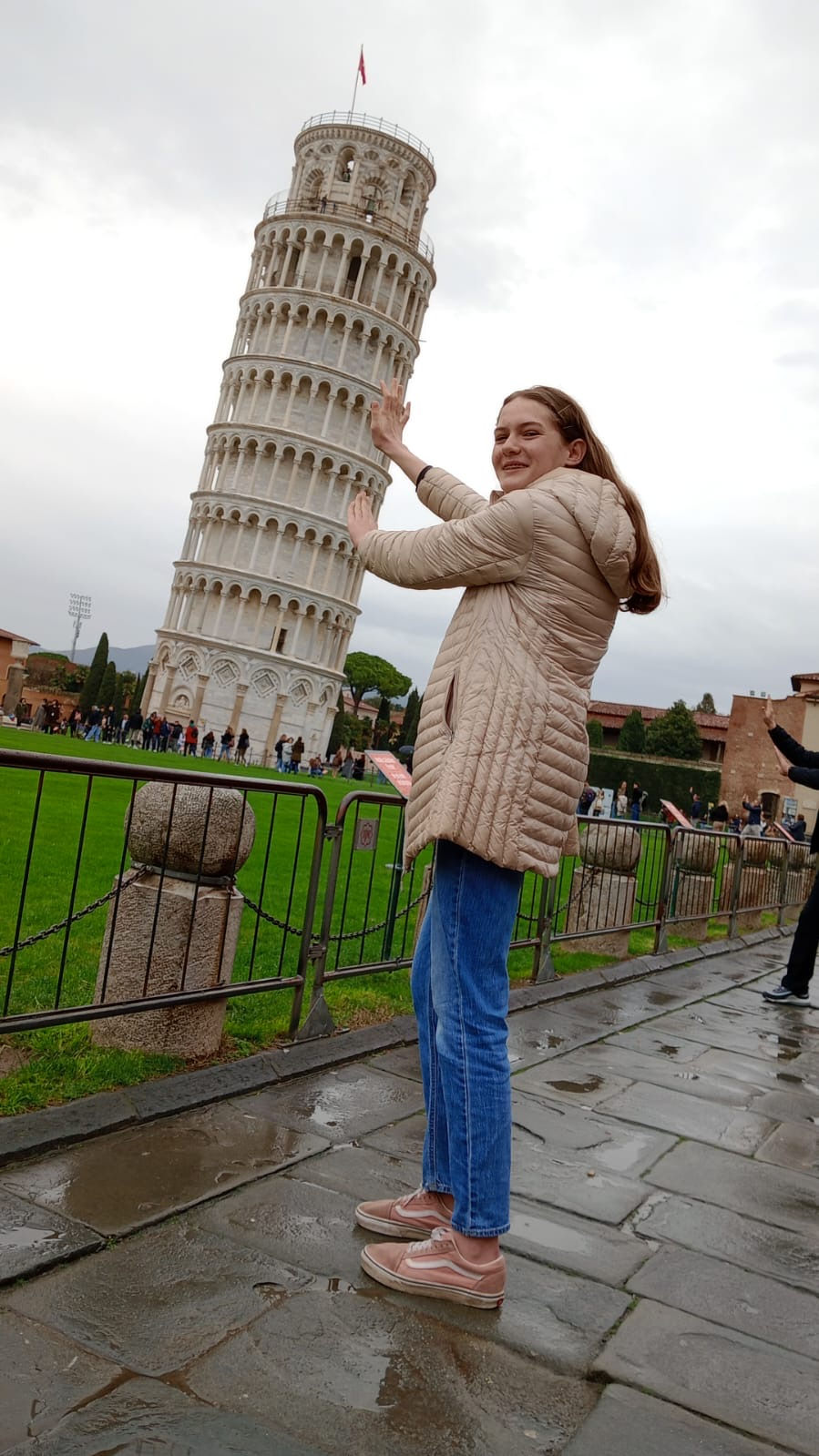


As you can see, Jeff struggled the most. Then we got back on the train and headed to Venice!

In Venice, we stayed in a hotel and found FABULOUS pizza just down the street for dinner. The pizza just got better and better as we traveled through Italy. YUM!

Our first view of Venice was on Thursday morning. We are all in love with this city!



Latin: Acqua Alta means Water Depth. These are measurements of when the tide was so high it flooded the city. Some are official, carved in marble around the city...



And some are just handwirtten like this one from 2019. Flooding in certain parts of the city is pretty common. You can learn more about it here (watch the videos at the bottom of the page). Venice has such an interesting history! I think this video covers what we learned pretty well if you are interested in learning more.

Garbage men. They collect garbage daily in Venice. The streets were so clean and quiet. It wonderful!

More amazing pizza!

There are extra-narrow walking paths everywhere. There are no cars, scooters, or anything motorized on the island, which makes it so quiet and charming. You hear people talking and kids playing. It was easy to imagine what life would have been like before we had all of the noise pollution motors bring. I loved it!


Every canal house had a front door on the street and side doors off of the canals, so you could easily get inside from your boat.

Our guide showed us how to spot hundreds of years-old graffiti. Just shine your phone light up, and you will see all kinds of pictures and messages from centuries past.


And old doorway shaped specifically for barrels to easily pass through.

It was cool to see the influence of Islamic art styles in the architecture. They call this style Venetian Gothic. Our guide told us that the Venetian economy was heavily bound up with trade with both the Islamic world and the Byzantine Empire, and the architectural styles of these two are somewhat entangled. You can learn more about it here.

It was pouring rain when we reached St. Mark's Basilica, so I found this photo on Google. Can you see the similarities between the mosques we saw in Turkey and this building? Islamic and Byzantine influences are everywhere in Venice!

Outside of St. Marks Basilica.

We saw the symbol of the lion with wings resting his paw on a book everywhere in Venice (paintings, statues, even the Venician flag). It is the symbol of St. Mark the Evangelist, the patron saint of Venice, whose body is laid to rest here. You can learn more about this symbol and Venice's connection to St. Mark here.

The Doge's Palace is connected to the Basilica. Doge, which means"duke," was the highest official of the Republic of Venice for more than 1,000 years (from the 8th to the 18th century) and a symbol of the Venetian state's sovereignty. It is a beautiful example of the Venetian Gothic style.

One of the four mosaics on the façade of St. Mark’s Basilica tells the story of how St. Mark’s body was taken from Egypt to Venice. This one shows how St. Mark’s body, stolen in 828 A.D. by two Venetian merchants, was hidden in a large basket covered with fruits, vegetables, and pork. The reactions of the Muslim customs officers at the sight of pork are quite explicit, as you can see in the mosaic: one of them pinches his nose, and another turns away, showing disgust. Thanks to this trick, the merchants were able to smuggle St. Mark's body to Venice.

Do you see the golden-winged lion above us?

So many moments when I felt like I needed to pinch myself. It was just so beautiful and magical!

Next, we met to learn more about the gondolas we saw everywhere in Venice. Here, our guide explains the symbolism of the front of the gondola. So much goes into creating these beautiful boats! You can learn more about gondolas here.

Next, it was time to climb aboard!

They only held up to five, so I went with the twins and Jeff with Ollie and Norah.
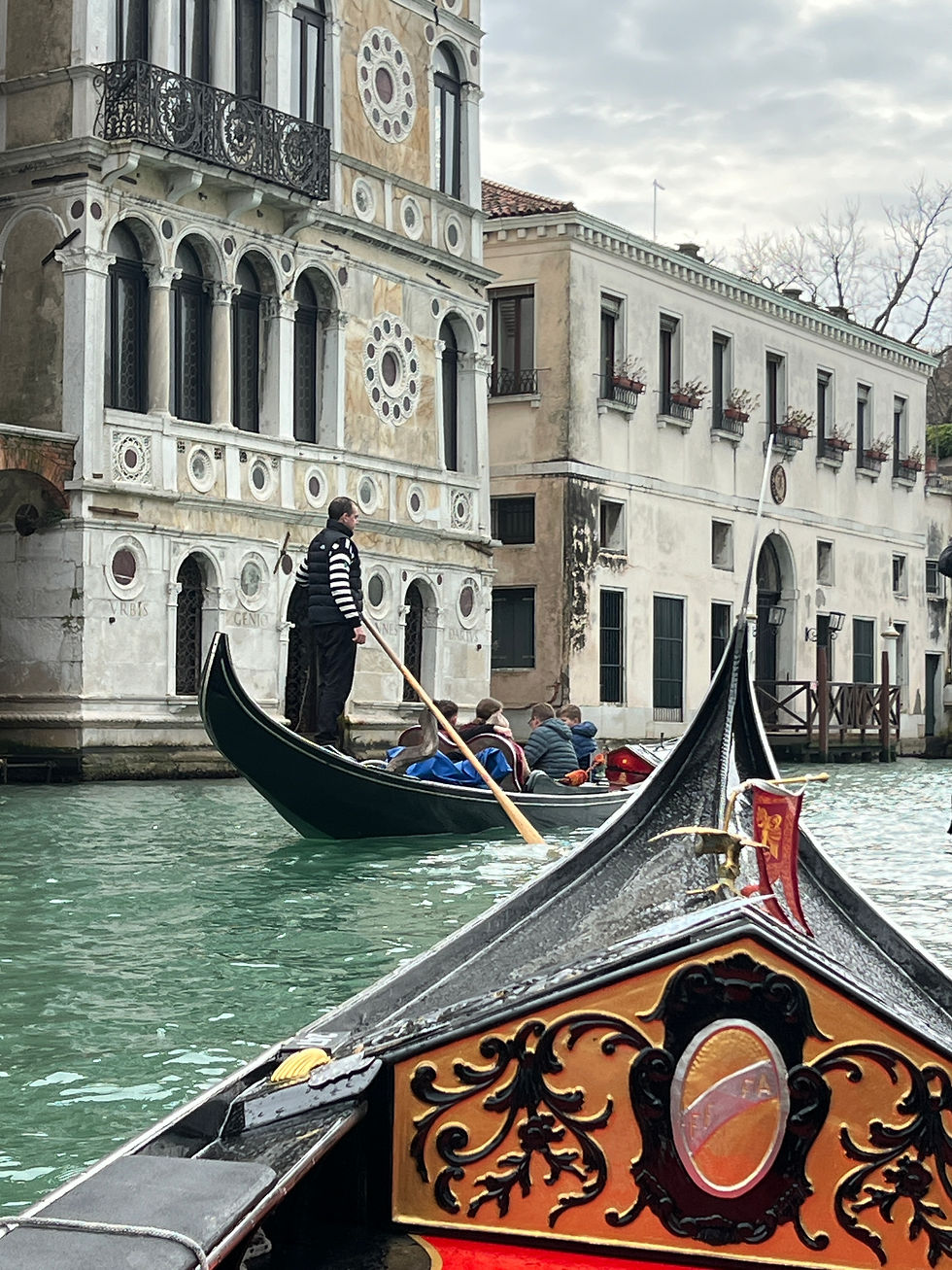
The details were so beautiful!



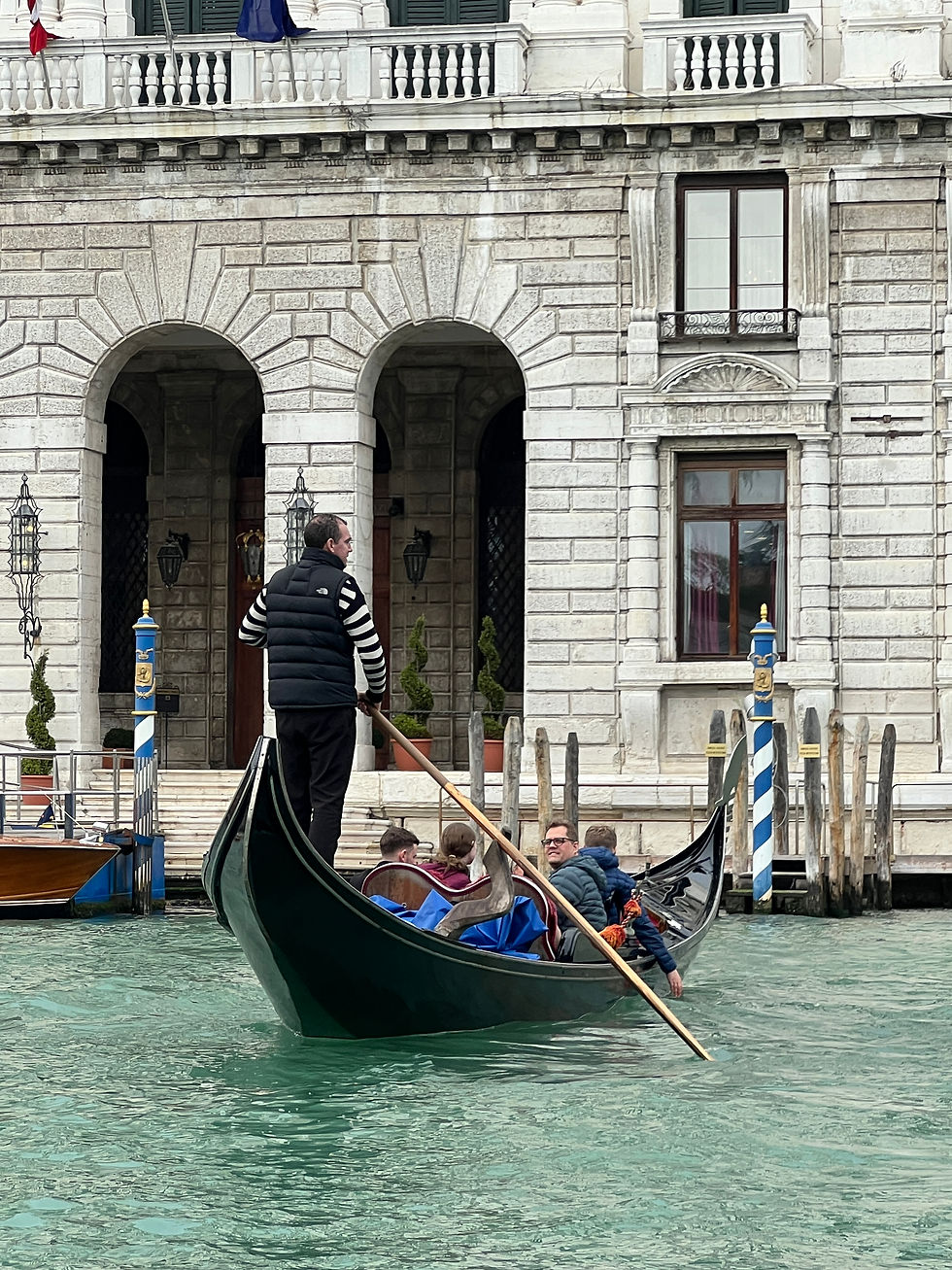
Hi Jeff! It was so calm and enjoyable.

The next day, we rushed to make our tour of the Murano and Burano islands. Our train arrived 20 minutes later than scheduled, making it almost impossible to get to the meeting place on time. If you don't arrive in time, you not only miss the tour but still pay for it. This tour promised to be amazing and cost us a pretty penny, so the idea of missing it was STRESSFUL! We ran through rain puddles and prayed like our lives depended on it and ended up missing it by about a minute. Luckily, another tour right after our time slot had enough room for us, and we got approved to join them, so everything worked out. PHEW!

As we started off to the islands, we saw a new sculpture done in 2019 by Italian artist Lorenzo Quinn. He created this monumental sculptural piece in Venice. He explains:
“Each pair of the sculpture’s hands celebrates one of six universal human values: Friendship, to build on the future together; Wisdom, to make mutually beneficial decisions; Help, to cement lasting relationships; Faith, to trust in your heart and self-worth; Hope, to persevere in worthwhile endeavors; and Love, the fundamental purpose for it all.”

Next, we arrived in Murano and toured one of the famous Murano glass factories. It was really cool to watch these artisans at work!

Glass balloons hanging from a tree.


Beautiful (and really expensive) Murano glass! This set was filled with 18-karat gold.
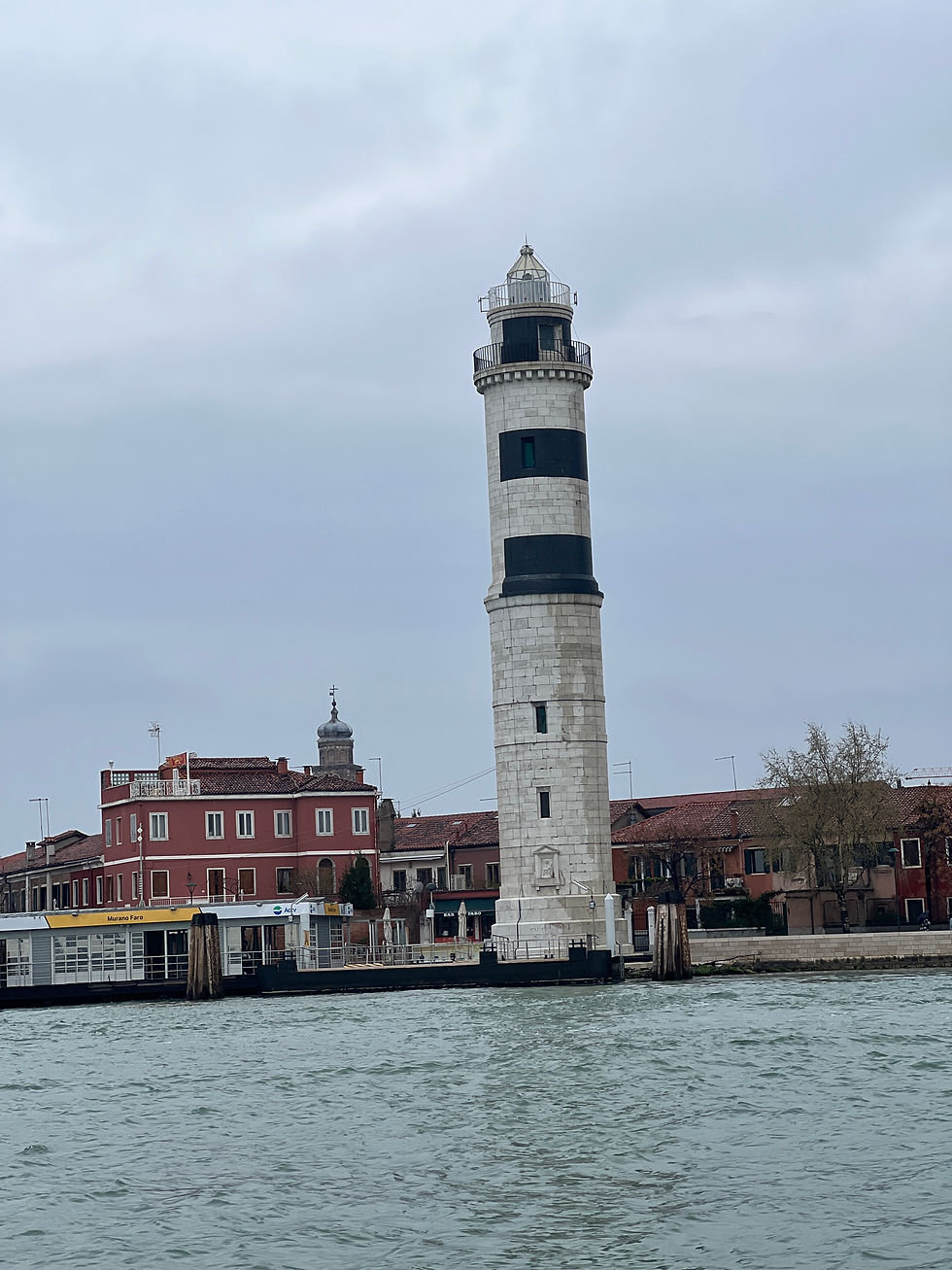
Next, we headed to Burano Island to see how Burano lace is made.

And you thought Pisa was the only city with a leaning tower. Turns out there are three of them in and around Venice!

Next, on the tour, was discovering the beautiful town Burano

It was so quiet and so colorful!

This is where the famous Burano lace is made by hand. We were so lucky to see the process demonstrated by one of the last artisans to know the craft. Sadly, it is dying with very few young people interested in learning it. The shop we were in was full of the most beautiful pieces, most of which were done by hand, one little stitch at a time. Here's a great video showing what the process looks like. Also, this short video from 1935 is so sweet.
After looking around the shop, we explored Burano. It was raining hard most of the time, but the colors were still vibrant, and everything was so charming.



After Burano, it was time for us to head back to the main island of Venice so Jeff could get to work and the kids could do school. Maisy and I got to stay behind for an extra special evening planned just for her.

Umbrellas everywhere

But also beautiful little reminders of spring.

Another leaning tower.

Maisy is a huge fan of Vivaldi, and when I learned he was born and lived his life here in Venice, I knew she would be so thrilled. There was a small museum dedicated to him right in the center of town, so we went and learned about his amazing life (like, did you know he was a priest and that he taught orphaned girls to become masters?). We also got to see a lot of old string instruments. Here's a respectful and thoughtful overview of Vivaldi's life.

After the museum, we walked around Venice together and just enjoyed the details

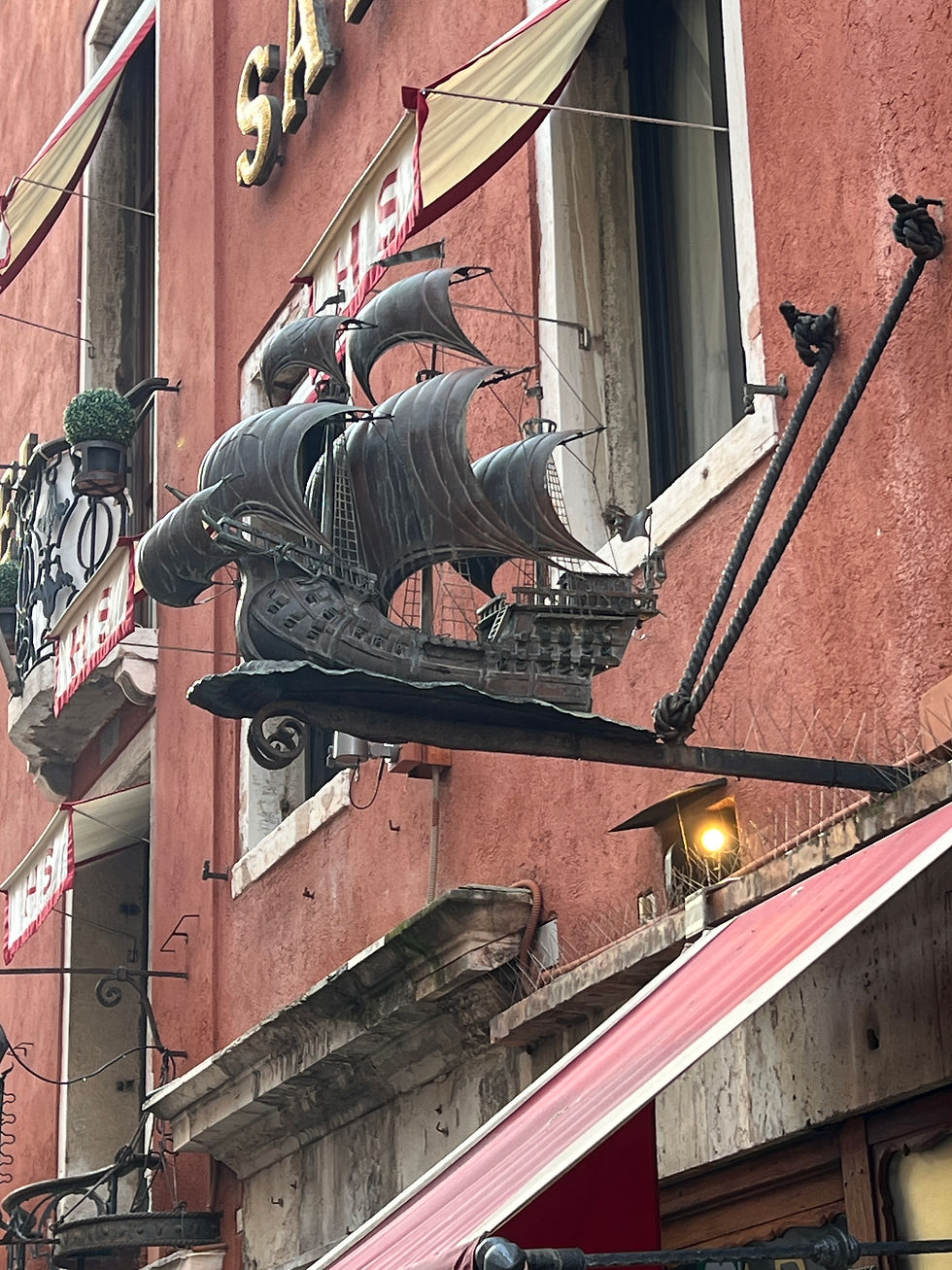



Maisy really wanted to try Italian hot chocolate (almost like drinking chocolate custard - very rich and very thick). And then it was time for...
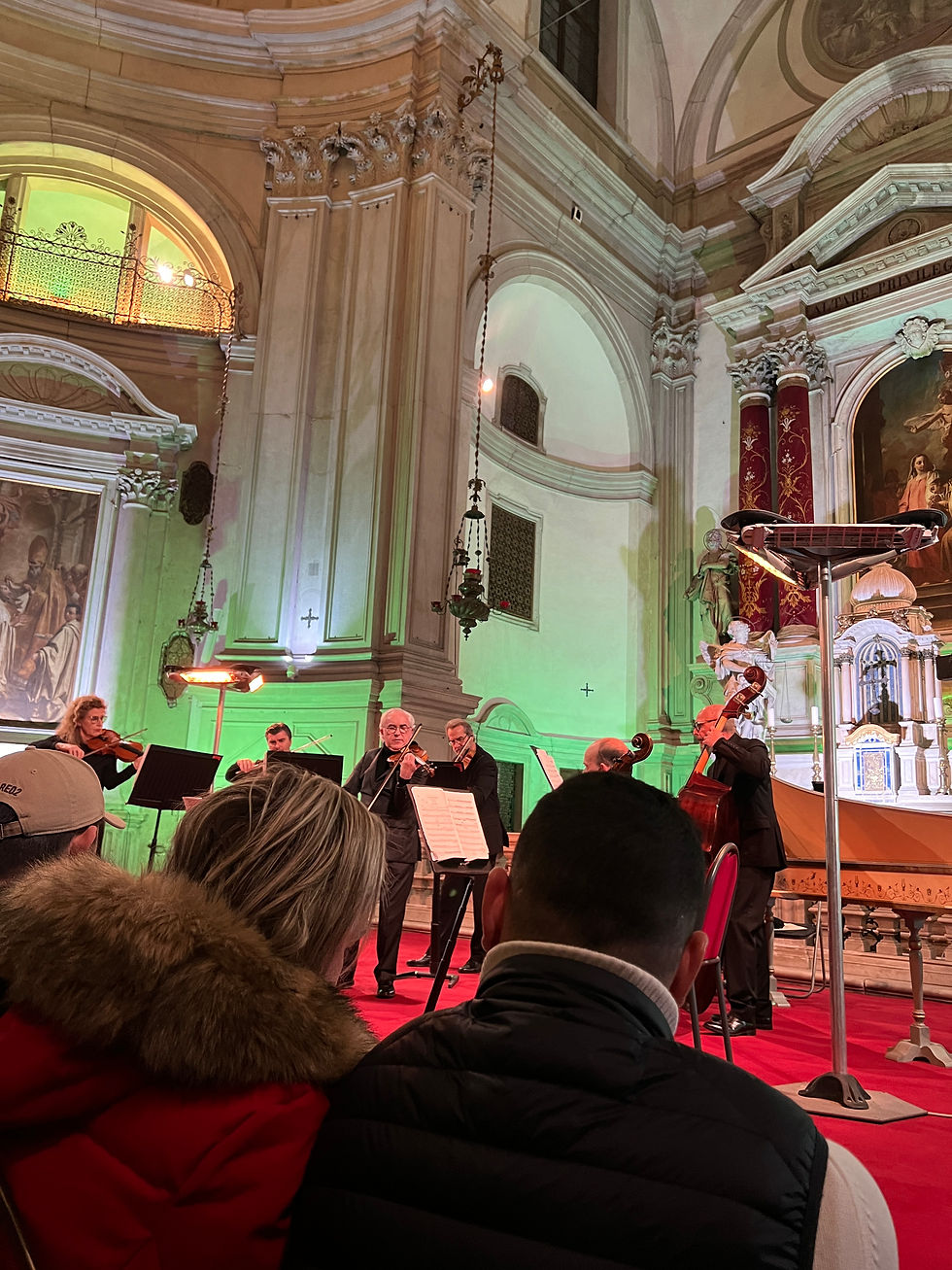
The Four Seasons concert in the church where Vivaldi taught and worked. No words for this concert. I have never experienced anything like it. The musicians were so incredibly talented, and the music was beyond this world. I found a video of some others playing it to give you an idea.

It was one of the greatest highlights of the trip for both of us, and so special to get to do it together. I love this girl so much!

On the way home, we were waiting for our boat and realized standing right across from us was the only woman in the chamber orchestra. Of course, we had to tell her how much we loved the concert. Once the other people waiting for the boat realized who she was, we all clapped for her. Then we told her about Maisy's goal to become a professional violist and asked if she had any advice. She looked right into Maisy's eyes and gave her a warm smile and then a lot of wonderful advice. She was so humble and kind. I'm so thankful for amazing human beings like her!

Venice at night. A night I will never forget.

The next day was a travel day (on to Vienna, Austria) and a morning I would like to forget! We misunderstood where we needed to get off and missed a very important stop, which meant we missed our big train out of the country. We were so stressed trying to figure out how to get to the train station to catch it, but, in the end, we couldn't do it. We ended up waiting for a long while to get back to Venice's Saint Lucia Main Station. At least Maisy made the most of it and used the time to practice. The rest of us cried. So we got a bonus day in Venice which turned out to be really great...

We found a luggage storage place and looked around some more. We discovered the reason the main station is named Saint Lucia. It's because the remains of the famous martyr Saint Lucia are here!


For most of the kids' lives, we have celebrated St. Lucia Day on December 13th. We learned about how it is celebrated in Scandinavia, but I remember learning that it was celebrated in Italy as well. Little did I know she lived and died here. The story of St. Lucia (or St. Lucy) has many variations. My favorite is the version that tells of a young Christian girl who brought food and clothing to families in hiding for their beliefs. This version tells that Lucy wore the crown of candles on her head to light her way so that her hands could be free to serve and help those in need. Her light is a preparation for the light that came from the Star of Bethlehem and the birth of "The Light of the World." You can learn more about her here.

We stopped for a yummy lunch and then headed to the train station to (hopefully) catch a train to Vienna! We were successful! But then, about an hour into our trip, we learned that another train had broken down and was blocking our train from proceeding. After changing trains and waiting for hours, we were finally on our way to Austria!

The train food was so delicious even if we were eating at 11 p.m. We finally arrived at our hotel in Vienna at around 3 a.m. We had come to Vienna for the sole purpose of going to a church area conference that one of our friends in Istanbul told us about, so we knew we needed to get to the hotel where the conference would be by 9 a.m. We slept fast and got up and dressed to go. When we went downstairs to have breakfast, we noticed two couples of senior missionaries! We were so thrilled to see them! We assumed they were there for the conference, too, but learned they were on their way home to Munich after a mission conference and wouldn't be attending the conference because there wasn't room. They told us the sad news that we wouldn't be able to go either. We were surprised and sad but also understood that there was limited space and wanted to make sure the local members could attend and enjoy the power of meeting together with others in the area. We went back to bed! After we woke up, Jeff and I had a nice stroll around the hotel. The buildings were so clean and ornate.




It was nice to sneak away and just be the two of us together for an afternoon. I'm so thankful for this guy!
Until next week!







Comments